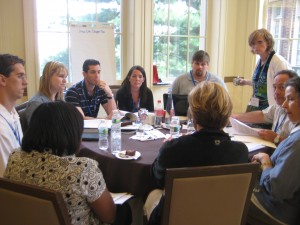Lead Your Team through the Profile, Part 2: Activity to Understand Differences
This exercise is part of a series to use as you guide your team through understanding their profile reports.
For You To Think About
When you are first introduced to a new co-worker, you may recognize a strength set and style different from our own. It’s natural to be attracted to differences, acknowledging how another’s strengths complete you. But as a relationship progresses, perspectives change. Often the traits you initially valued as strengths become the very things that you soon judge as weaknesses.
The Law of Differences holds that there are just two paths we can take as we observe others’ differences.
- We can value another’s individual differences (focus on strengths)
- We can judge another’s individual differences (focus on weaknesses)
These two pathways have different, even opposite outcomes. When we judge, we tend to see another’s differences as weaknesses. When you value another’s differences, we see the strengths that God gave them. Valuing differences leads toward relational unity and oneness on your team.
For You To Do
The exercise will help your team members understand the Law of Differences and apply it to unite the team. Often people are unaware that they judge others. As members challenge their previous ideas about strengths they discover how to value others on their team and build unity.
What You Need for This Exercise
- Copies of the article, “The Law of Differences” (one for each participant)
- Each participant’s profile report
- Paper and pencils or pens for each participant
What To Do
- Distribute copies of the article, “The Law of Differences,” to each member of your team. Allow members time to read through the article.
- Explain that the Law of Differences holds that God created each person with a unique (different) set of strengths and then purposely placed us in relationships. Ask team members to discuss the Law of Differences in light of what they discussed in the opening devotional, based on the word picture of the human body in 1 Corinthians 12.
- Have each participant turn in their profile reports to page 5 and view the Strengths Chart. Ask them to share with the group where they plot on the Problem Solving continuum.
- Lead your team through a discussion about how people truly view differences.
Have participants consider how they judge the opposite approach to problem-solving and record their responses on a sheet of paper.
Once participants are finished, lead a discussion about the thought process that typically drives how people view differences. How can judging another’s response to solving problems, for instance, create conflict and division on a team?
- Lead your team through an activity in processing differences.
Ask participants to flip over their papers. Have participants consider the strengths associated with the opposite side of the problem-solving continuum to theirs. How might the opposite strengths protect them? How might the opposite strengths complete them if embraced? Invite participants to share their ideas.
Once they are finished, lead a discussion about the thought process that embraces differences. How can valuing another’s response to solving problems, for instance, create closeness and unity on a team?
- Summarize. Ask participants to share one thing they learned about differences during this activity.
For You To Take Away
Now you are the body of Christ, and each one of you is a part of it. (1 Corinthians 12:27, NIV)
More Exercises to Help You Use the Profiles
Your Team Through the Profile, Part 1: Group Devotional
Lead Your Team Through the Profile, Part 3: Understand Your Team Members’ Differences
Lead Your Team Through the Profile, Part 4: What Value Do You Bring to Your Team?
Lead Your Team Through the Profile, Part 5: Checklist for Communicating
Lead Your Team through the Profile, Part 1: Group Devotional
God Made Us to Complete Each Other, Not Compete With Each Other
For You To Think About
In 1 Corinthians 12, Paul uses a word picture to describe healthy relationships: the human body.
Like He does elsewhere in scripture, God provides us with this tangible image to help us understand an intangible concept. Each part of the human body is unique and fills a special role. Likewise, each member of a team is unique and fills a special role.
As you look at the human body’s different parts it is easy to see how they interconnect. Taken separately, a fingernail and a larynx and a kidney and a hair follicle are completely unique. Each is an independent unit but dependent on all the others to form the whole.
The same is true for the members of your team. Each is unique. God placed you together to complete each other, not compete with each other.
For You To Do
Use this exercise as an introductory group devotional with your team as you begin the process of leading them through their profile results together. The powerful image of the body (a team) offered in this scripture can help your members understand the importance of their individual strengths working together.
- Distribute copies of 1 Corinthians 12:12-18 to each member of your team. Read the passage together.
- Encourage members to share their insights as you lead the following discussion.
- 1 Corinthians 12:12 says, “Just as a body, though one, has many parts, but all its many parts form one body, so it is with Christ.” God uses repetition in scripture to emphasize a point. Compare verse 12 with verse 14. What does God want us to understand about the body – a team – and its parts? Referring to the image of the body, explain how God intends for different members of a team to be “one.”
- Paul explains the human tendency to deny the truth about individuality: “If the foot should say, ‘Because I am not a hand, I do not belong to the body,’ it would not for that reason stop being part of the body. And if the ear should say, ‘Because I am not an eye, I do not belong to the body,’ it would not for that reason stop being part of the body” (vs. 15-16).“Simply saying a person doesn’t belong doesn’t make it true.” Do you agree – or disagree? Describe the tension between individuality and belonging. What are some reasons people may deny others the opportunity to belong? How does the enemy use denial to create division on a team?
- Verse 17 says, “If the whole body were an eye, where would the sense of hearing be? If the whole body were an ear, where would the sense of smell be?” Paul explains that each part’s function has value. Why do we tend to believe that one individual’s function has more value than another? Imagine that your part’s function is affirmed by others in the body. How does validation motivate you?
- Now that you have studied this passage, describe how you think God views a team and its members.
For You To Take Away
Just as a body, though one, has many parts, but all its many parts form one body, so it is with Christ. (1 Corinthians 12:12, NIV)
More Exercises to Help You Use the Profiles
Lead Your Team Through the Profile, Part 2: Do Differences Divide or Unite Your Team?
Lead Your Team Through the Profile, Part 3: Understand Your Team Members’ Differences
Lead Your Team Through the Profile, Part 4: What Value Do You Bring to Your Team?
Lead Your Team Through the Profile, Part 5: Checklist for Communicating
As you may know, Ministry Insights helps people understand biblical truth about God’s divine design for differences.
We provide biblically-based tools to help you build healthy relationships, including free resources on our website. This content offers biblical teaching and practical ways you can discover and use your strengths in your relationships.
Here is a brief glossary of content items we provide to help you understand and use your strengths.
Articles
Articles provide informational material about differences and strengths. You may want to consider articles as “user guides” for Leading From Your Strengths tools. They include:
- Steps in the process of discovering your strengths, valuing strengths in others, and blending strengths
- Explanations of the four different strengths scales
- How strengths can work in your job, marriage, family, or ministry
- User-friendly explanations for profile reports
Articles are posted on our website and are distributed weekly to Ministry Insights subscribers on a rotating basis with Devotionals and Insights.
Devotionals
Devotionals are short written pieces that help you grow individually in your relationship with God. Specifically, our devotionals equip you to hear as God speaks to you personally about using your strengths. Each refers to a specific topic and scripture verse. Devotionals also include prayer points related to that topic and verse for you to use in your time with God.
Devotionals are posted on our website and are distributed weekly to Ministry Insights subscribers on a rotating basis with Articles and Insights.
Insights
Insights, our newest type of content, are short articles that equip you to put profile data into practice in your everyday life. Each one centers on one truth about differences, explaining that principle from a biblical reference. At the end of each Insight is a practical exercise, “Now How Shall I Live?” that you can use to help you put the principle into practice. Insights are structured so you can read them in five minutes or less.
Insights are posted on our website and are distributed weekly to Ministry Insights subscribers on a rotating basis with Articles and Devotionals.
Features
Can there be anything more exciting than to experience God’s transformation? Feature articles give encouragement by showing strengths principles in action, including:
- Stories of individuals who use Leading From Your Strengths tools in their life or ministry
- Profiles of organizations or churches that have incorporated Leading From Your Strengths tools for healthier team results
- Events that equip leaders, spouses, families, and workers to use their strengths more effectively
Features are published monthly on our website and delivered to Ministry Insights readers in our monthly online newsletter, Instant Insighter.
Exercises
Exercises are practical activities you can use one-on-one or in a group in order to put profile data into practice in the workplace, home, ministry, and relationships. Each exercise includes a step-by-step list of what to do to get the most benefit from the activity.
Exercises are posted on our website and distributed periodically by email to Ministry Insights subscribers.
You May Also Want to Read
This exercise helps you have meaningful interactions using profile data in conversation.
For You To Think About
Words have incredible power; they can be unifying or isolating. Think back to a time when you were on the receiving end of harsh words. You may have felt weak, abandon, hurt, or rejected. Now think about a time when you received authentic praise. Those words likely raised your spirit and drew you to the speaker.
Each of us holds the key to unity and oneness – through our words.
Consider your last exchange with your spouse, a friend or a colleague. Then think about that new person at work or a newcomer to your volunteer team. You may find yourself frustrated when interacting with those close to you or you may catch yourself walking on eggshells with the new people that come into your life – in both cases, simply because communication breaks down.
 Yet because you have access to your profile, you have a tool and a process that can help build God-honoring relationships in your life. The key is to apply the information you already have through meaningful conversation.
Yet because you have access to your profile, you have a tool and a process that can help build God-honoring relationships in your life. The key is to apply the information you already have through meaningful conversation.
For You To Do
This exercise sets up a warm, inviting environment in which you and a friend can have meaningful interactions through conversation – using your profile data.
- Identify a person God has placed in your life … someone with whom you would like a stronger relationship.
- Invite that person to take the Leading From Your Strengths Profile Assessment (use this coupon code: FRUIT). The assessment will take 10 minutes or less. Have a copy of your profile on hand to show your friend.
- Once your friend has received the results and has had a chance to read them, schedule a time to have coffee together.
- Ask your friend to refer to his profile’s General Characteristics section. Invite your friend to highlight 3 statements from each paragraph that most closely resemble truths he sees in himself, for a total of 9 statements. Do the same in your profile.
- Ask your friend to share the first statement he highlighted in the profile, why he thinks it is true, and how he sees it evidenced in his life. Offer your feedback about the statement.
- Share the first statement you highlighted in your profile, why you think it is true, and how you see it evidenced in your life. Ask for your friend’s feedback about the statement.
- Repeat the process until you have both shared each highlighted statement in the profiles. Discuss what surprised you or affirmed what you already knew about each other.
- Ask each other: how do words hold the key to building oneness in a relationship?
For You To Take Away
The tongue has the power of life and death,
and those who love it will eat its fruit. (Proverbs 18:21, NIV)
Every person has strengths. But do the people in your life know theirs … and understand how to use them?
You can help those around you understand and use your strengths together. Invite one of the speakers from the Ministry Insights team to share about leading from your strengths with your group at one of these events.
Different By Design
 What It Is
What It Is
A Different By Design event equips Christian couples like you to take this step – to discover and use your God-given strengths in your marriage, to value your spouse’s strengths, and to blend. Your day will be filled with insightful teaching, experiential exercises, and meaningful discussions that will strengthen your marriage relationship.
What You Learn
Every couple faces four inescapable areas of differences: problem solving, processing information, managing change and facing risk. These areas seam to drive a wedge in more relationships over time than any other. The conference will open your eyes to God divine design for differences. Together you’ll learn how to use your personal strengths to –
- Design effective communication strategies
- Problem solve more effectively
- Exchange information that is meaningful and practical
- Balance the scales of a transitioning home environment
- Work together when making decisions
Format
This event is normally hosted by a local church and presented on a Saturday (8 AM – 5 PM) with an onsite break for lunch. If Different By Design is to be conducted as a small group study series at your church, you can host a kick-off event on a Saturday morning lead by a certified practitioner.
Find out more about hosting a Different By Design event.
Love and Money One Day Event
 What It Is
What It Is
Two factors that impact marriages more than any others: how we understand Love (relationships) and Money (finances). How we handle money often leads to conflict in marriage. But the underlying issue is often miscommunication and misunderstanding.
The Love and Money One Day Event opens your eyes to how communication and money really work together in marriage.
What You Learn
- How to understand your spouse’s strengths
- How to exchange information that is meaningful and practical
- How to work together to make financial decisions
- How to build oneness in love and money
Format
This event is normally hosted by a local church and presented on a Saturday (8 AM – 5 PM) with an onsite break for lunch.
Find out more about hosting a Love & Money event.
The 210 Project
 What It Is
What It Is
Among life’s most pressing questions are:
- Why am I here?
- What does God really want me to do with my life?
The 210 Project is a practical, step-by-step process based on a simple, yet powerful scripture verse – Ephesians 2:10 – which equips you to discover your calling. The process includes a book, an on-site experience, and online interactive exercises to help you understand God’s unique calling on your life.
What You Learn
In The 210 Project equips you to discover your unique spiritual DNA. Through it you come to understand who you are (your unique strengths and your spiritual gifts) and what you’re made for (your passion and your story).
The Format
This event is normally hosted by a local church as a church-wide study or a small group study. You can host a kick-off event on a Saturday morning lead by a certified practitioner.
Find out more about hosting a 210 Project event.
Team Building Staff and Leadership Event
 What It Is
What It Is
A facilitator guides your staff or team to build understanding about each member’s unique strengths, discovering how to value and blend their strengths. Then, your team transitions from learning to application. Prior to your event, each member completes a Leading From Your Strengths profile. During your event, members build on the insight from the profile reports.
What You Learn
- Biblical Foundation: your group examines God’s design for differences
- Self-Understanding: each participant discovers his natural strengths.
- Team Understanding: members recognize the unique qualities and strengths in other participants.
- Communication: the team learns to interact in the group productively with fewer conflicts.
- Cohesiveness: the group works to blend member differences to bring out each others’ strengths.
- Efficiency: members increase overall team effectiveness.
- Problem-Solving: members acquire a new approach to team problem-solving.
- Application: your team adopts “C.L.E.A.R.,” a 5-step learning process that equips members to transfer information to application.
The Format
This event is normally hosted by a team leader, pastor, or manager and presented to a team at a time which best fits the organization’s schedule. You or a leader can facilitate the event after completing Level 1 Certified Training (available online) or by using a Ministry Insights certified trainer.
Find out more about hosting a Leading From Your Strengths Team-Building Staff and Leadership Event.
More Articles about Getting Equipped and Equipping Others
The Gift of Strengths: How You Can Empower Others to Know and Use Theirs
Three Ways Practitioners Use Curriculum to Equip Couples
Healthy, mutually supportive marriages become that way intentionally.
So say our certified practitioners, who use Different By Design marriage curriculum in all kinds of settings. Different By Design guides couples through the process of identifying their individual strengths, their spouse’s strengths, and how to blend strengths to build oneness.
Because of its flexibility, our certified practitioners have used Different By Design in different venues, but all agree on one thing: the material has a powerful impact on marriages.
Different By Design at Marriage Retreats and Marriage Workshops
Participants often cite a Different By Design event as a turning point in their marriage in that the material arms a couple with the information they can begin to implement right away and use for the rest of their lives. The experience equips good marriages to become great and helps struggling marriages to rebuild into stronger ones.
“Couples have clear ‘Aha’ moments during the event,” says facilitator Darlene Morgan (Alberta, Canada). She and her husband Mike, 38+ year ministry veterans, have led both Leading From Your Strengths and Different By Design at workshops and retreats. “The first light bulb goes off when both husband and wife discover that their differences are strengths.” The Marriage Insights profiles, completed as part of the experience, help spouses see their differences objectively on paper.
But the second moment of understanding can be even more powerful, says Darlene. “Once couples understand they have a choice to value their spouse’s strengths, rather than judge them, they are ready to move forward.”
Paul and Carol Tepker saw proof of that understanding when they led a Different By Design workshop near their home. One couple, from Tepkers’ home church, announced that their marriage had been broken for a while and they were ready to separate. The workshop was a last-ditch effort to save their marriage. Shocked and dismayed, Paul and Carol nevertheless committed to supporting the couple throughout the workshop and in prayer during the weeks that followed. Six months later Paul and Carol received an invitation to the ceremony for the renewal of the couple’s marriage vows. Different By Design was the beginning of the renewal process in their marriage.
Different By Design in Marriage Counseling
Different By Design’s objectivity, says Jimmy McLeod of Becomer Counseling (Fort Worth, TX), brings a rational voice during crisis or turmoil. Such was the case as he counseled Robert and Jessica, whose 15-year-marriage had been wounded by unfaithfulness. Both were biblically committed to restoring the marriage.
The profile data gave both spouses sanity and focus as they worked through the emotions of broken trust. Jessica discovered that she moved quickly to assumptions and judgments. She learned to give Robert more time for decisions and responses. Meanwhile, Robert saw his temptation to marinate about a decision forever. He came to appreciate Jessica’s quiet prods to think, choose, and move on. The couple has been in counseling six months, but already their communication has better than it has ever been, says Jimmy. Even their four children are noticing changes in the relationship and in family life.
“The profile and the curriculum put the information into a format they could understand,” said Jimmy. “The material freed Robert and Jessica to stop beating themselves up and instead use the information in their immediate circumstances – and move forward into the future.”
Different By Design in Marriage Preparation
“This was the most helpful part of our pre-marital counseling.” More than one couple has shared that insight after participating in the Different By Design curriculum. Marriage preparation counselors ask the couple to complete a video session and exercises for each session and then meet together to talk about what they have learned. The profile data and exercises are springboards that spouses can build upon throughout their marriage. Multiple pre-marital couples can also gather to debrief after watching the videos.
One 30-something professional couple invested considerable time in coming to understand their personal strengths outlined in their profile reports. During pre-marital counseling, they developed a deep appreciation for one another. The wife-to-be, a quick thinker, came to understand why her fiancé could not make hurried decisions. She began to view his thoughtful, systematic insights as valuable. Meanwhile, her future husband discovered how his future wife was relationally wired and a perfect fit for his more reserved nature. By the time their wedding day arrived, the couple was ready to use the tools they had learned to keep growing together.
Many Settings Offer Opportunities to Build Marriages
Its versatility, say, practitioners, make Different By Design suitable for couples of all kinds to build vibrant marriages, whether it is used in ministry teams, small groups, Sunday school classes, or couples classes or even given as a gift for a wedding, anniversary, or Christmas. As spouses understand and value each other’s strengths – and then draw on those differences to feel understood, to be valued and fully integrated – they learn healthy ways to effectively communicate and cooperate with the other.
That marriage can be your marriage – and the marriages of those you know and love.
More about how other ministries use profiles and curriculum
Tony Husted on Coaching the Coaches With the Profiles
Counselor Jimmy McLeod Invests in Marriages and Teams With Profiles
CEO Uses Profiles to Build His Team — and Others
Coaching: Life Coach Guides 20-Somethings to Identity and Purpose
Transitions: Canadian Leader Helps Midlifers, Teams Transition Well
Versatility: Pastor, Educator Uses Profiles Across Ministry Areas
Using the Profiles: Adventure Kit Helps Children Discover Their Strengths
Coaching: Ministry Consultant Uses Profiles to Grow Teams
Profiles Help Grow Young Leaders in the Latin American Church
Coaching: How to Help People Apply the Profile
Leadership: Building Up Leaders Down Under
Do You Color Inside the Lines or Outside the Lines?
As the marriage conference presenter continued to speak, Darlene glimpsed over at her husband. Roger had flipped his conference booklet page to the next page and was busily filling in blanks.
Darlene nudged him. “You’re not following the speaker’s directions,” she hissed.
Roger stared at his wife. “Why do I need to stay with him?” he whispered back. “I get what he’s saying. I want to get started on the exercise!” He shakes his head. Why was his wife so rigid about rules?
Roger and Darlene had just experienced the different ways they view structure and procedures.
You’ll recall this couple had been invited by friends to the marriage conference, never expecting the content to be meaningful. Both were surprised to learn that their God-given differences were actually strengths in disguise. As Roger and Darlene continued to listen to the conference speaker, they discovered that each of them solved problems, processed information, and managed change differently … yet those differences could make them stronger together.
Now Roger and Darlene were about to learn about the two very different ways they faced risk.
Do You Color Inside the Lines or Outside the Lines?
When it comes to facing risk, some people like to play it safe while others push the envelope. One way to discover how you view risk is to ask yourself how you view rules.
Darlene, for instance, is Structured. To her, rules are a source of protection – a way to manage challenges in an orderly, systematic way. As she listens to the speaker, she follows along point by point and fills in the handout blanks appropriately. Darlene likes to do things one way – the way the rules dictate. If the handout was a coloring book, she would use suitable crayon colors for each item and color inside the lines.
Roger takes a more Pioneering approach to risks and rules. To him, instructions, directions, and procedures are simply guidelines – even obstacles. He is more interested in accomplishing a goal than following the rules, even if doing so requires some risk. As Roger listens to the speaker, his mind jumps ahead with the desire to apply the information right away. While the speaker drones on, Roger thinks of different ways he can absorb the information and then turns the page to begin the individual exercises. If the handout was a coloring book, Roger would not only color outside the lines, but also make sure he tried every color in the crayon box.
Take Risks or Play It Safe – Which Is Best?
The problem arises in marriage not when spouses face risk differently – but when one spouse or both expect the other to color their way.
Roger and Darlene are a case in point. As Darlene nudges Roger to pay attention, she senses her anxiety rising. She and her husband might not understand the exercise if they don’t listen to the instructions! Meanwhile, Roger simply wants to find out how to communicate better and use the information, so he presses ahead. Darlene’s restraint irritates him.
Ecclesiastes 3:1 says, “For everything there is a season, and a time for every matter under heaven” (ESV). Each approach to facing risk has value.
What if Darlene quietly accepts that Roger must forge ahead? She can keep her attention on the conference speaker, feeling assured, safe, and able to follow along the presentation accurately. Her careful notes will help the couple as they discuss the presentation afterwards. Meanwhile, Roger can begin to work on his answers before instructed to do so, using the extra time to think about his wife. Elements of her personality have helped the couple manage their home in an orderly way – something which would be impossible for him to accomplish on his own. He will be ready to share that affirmation with her when they move to discussion time.
Inside the Lines and Outside the Lines Work Together
God has placed the Pioneer in the relationship to explore new options. The Structured partner is there to help the couple to create order. When each spouse values the way the other faces change, the couple is stronger.
“There is a time to embrace risk and move forward in different ways,” the conference speaker continued. “And there is a time to evaluate risk and take a more systematic, orderly route.” Roger looked up from his scribbling. He turned to Darlene and they both smiled.
Roger’s pioneering ways and Darlene’s structured approach work well together, the couple realized.
How do you and your spouse each handle structure? Take some time to color together … and find out.
Marriage Series: Different By Design
Different By Design, Part 1: Surprised By Differences With Your Spouse
Different By Design, Part 2: Incompatibility – a Powerful Basis for a Great Marriage
Different By Design, Part 3: Problem Solving Together With Your Spouse
Different By Design, Part 4: Processing Information With Your Spouse
Different By Design, Part 5: Managing Change Together With Your Spouse
Different By Design, Part 7: Make a Plan to Use from This Day Forward
ACE South Africa CEO Graham Yoko was first drawn to the Leading From Your Strengths profiles when listening to a Focus on the Family radio interview with Dr. John Trent, profile co-creator. “I have always been passionate about people finding their ‘groove’ in life,” says Graham. “This sounded like a tool that I could use with teams I coach.” He ordered a Team Building Kit from Ministry Insights and completed its complimentary, individual profile.
The results were so accurate that Graham had his leadership team at Accelerated Christian Education South Africa complete individual assessments, too. “The exercises transformed our team and improved our effectiveness on so many levels that we began telling other groups about our experiences,” says Graham. He has since used the profiles with ministry teams, couples, Christian business teams, and school staffs, becoming connected through his many speaking engagements or in the course of his work.
Team Profiles Are Like Puzzle Pieces – ACE and Elsewhere
In presenting the profile and associated team building exercises Graham uses the analogy of a jigsaw puzzle, likening each member of the team to a piece of the whole. A team never consists of only one piece but rather several or many, Graham says. Even in a marriage there are two pieces. Each puzzle piece interlocks with the others. He compares a person’s strengths to a puzzle piece’s protruding tabs, serving to add to and complete other pieces. Each team member – and each puzzle piece – also has indentations which others complete. Once team members grasp the reality that they are not a one-piece puzzle but are interdependent on those around them, they are able to value those around them. “It is at that point they readily defer to others in their area of strength,” says Graham. “The result is a happier, more productive, and focused team.”
Putting the Pieces Together in Practical Ways
In one instance, Graham presented the profiles to a ministry staff serving in a widely diverse community. The team was caught up in the challenges of prioritizing its activities and frantically assigning personnel to meet many needs. The leader’s hectic schedule left little time for planning and team building. Strengths were overlooked, leading to frustration. Graham’s task was to bring structure to the team. As the group completed the profiles and proceeded through the team building exercises, the proverbial light bulb came on. Recognizing that the profile is a living document that can be used with real life situations, the team implemented that data to assign tasks to members in line with their strengths. The leader was freed to be who he is supposed to be and welcomed other members of the team to fill roles in areas that he does not feel gifted. The group made a point to further apply their discoveries in other practical ways. The Strengths Wheel, a visual reminder of their collective strengths, is displayed in a prominent spot on the office wall and is now a focal point of all that this dynamic team attempts together. Each team member extracted a 6-statement paragraph from his profile detailing favorite and least-favorite modes of communication, and posted the personalized list on the front of his workstation. Colleagues discipline themselves to communicate in a way that is appropriate for that individual.
Objectivity: a Key Piece of the Puzzle
Prior to working with a team, Graham often encourages a team leader and spouse to complete the profile assessment first and read each other’s reports. The immediate feedback gives the couple a working document to apply immediately in daily life. On the rare occasion that a spouse raises questions about the results, the other provides wholehearted confirmation of the partner’s report. “The profile provides a neutral reference point for bringing people together,” says Graham. “Its credibility helps maintain objectivity … it is great to be able to deflect the attention away from the individual and put the ‘blame’ on the profile.” Once they have seen the benefit of recognizing and valuing strengths in their marriages, leaders are eager to take the process to their teams. The section outlining perceptions is particularly helpful in resolving interpersonal conflict. Graham’s organization now uses Position Insights profiles to define specific roles on the team. The data matches potential staff in terms of suitability to a position. “We do not hire any new staff until that individual completes the profile and we have the opportunity to compare their results to the Position Profile for that specific role,” says Graham. “In my experience, Leading From Your Strengths profiles are not just another personality or strengths test,” says Graham. “They are a life-giving and life-changing experience that makes working together fun … and allows team members to enjoy each other rather than having to endure each other. “
More about how other ministries use Leading From Your Strengths profiles
Coaching: Life Coach Guides 20-Somethings to Identity and Purpose Transitions: Canadian Leader Helps Midlifers, Teams Transition Well Versatility: Pastor, Educator Uses Profiles Across Ministry Areas Using the Profiles: Adventure Kit Helps Children Discover Their Strengths Coaching: Ministry Consultant Uses Profiles to Grow Teams Profiles Help Grow Young Leaders in the Latin American Church Coaching: How to Help People Apply the Profile Leadership: Building Up Leaders Down Under One-on-One Coaching Leads to a Whole New Purpose Successful Staffing Through Team Coaching
Now What? 3 Ways To Put Your Profile Data Into Practice
Fifth in a series explaining how Certified Practitioners help you process profiles
After you receive your Leading From Your Strengths profile assessment and review it with a certified practitioner, you discover your dominant strengths, particularly how you are most likely to respond in typical situations and under pressure.
This information is interesting – even intriguing. But now what?
Most of us want to know how to purposefully use our strengths in a healthy way to cultivate more productive relationships at home and at work. A certified practitioner can help you identify at least three ways to do so.
Three Ways a Practitioner Helps You Put Your Data Into Practice
1. You Can Maximize Your Natural Strengths
You have a unique combination of strengths – the ways you naturally solve problems, process information, manage change, and face risk. You view them one way. Others view them differently. A practitioner gives you exercises to help you understand how others view your strengths. This way you can know how to approach current or new situations to maximize your value to the team.
At the same time, a practitioner guides you through the process of identifying the strengths that resonate most with you. These are key factors in keeping yourself motivated – ones you want to find ways to cultivate. You’ll also discover what you need from a leader so that you can perform at your optimum level. This is important information to know as you change jobs or meet with your supervisor.
2. You Can Communicate More Effectively
When your practitioner asks you to review your report’s “Checklist for Communicating,” you will choose the statements that describe how you like others to communicate with you – and how you do not like to be communicated with.
In doing so, your practitioner affirms the value in your particular approach to communication and explains how your approach brings value to your relationships. The checklist also gives you concrete wording you can use with others to share how you want to interact with them. You can work with your practitioner to practice sharing those preferences with your team members or family members.
3. You Can Minimize Your Stress
When a practitioner studies your Strengths Chart (which reveals your natural way of handling problem solving, processing information, managing change, and facing risk) and your Strengths Movement Chart (which shows how you adapt to your current situation in those four areas), she documents the differences in scores. Specifically, she will notes movement of 5 points or more in any of the four areas and then helps you to identify the source of stress.
A side-by-side comparison of your natural strengths style and your adapted style further reveals the stress and pressure you may feel in your current environment. A practitioner helps you identify elements that contribute to this movement, such as your duties, expectations, or responsibilities. Some frustrate you. Others exhaust you. All reduce your performance in some capacity.
This is not to say you should avoid areas for improvement. On the contrary, for each of us has natural limitations or tendencies. When you know yours, you can create an action plan for managing them well and moving forward.
But a practitioner will also ask you several questions to get to the crux of the issue: which of these elements do you control and which are controlled by others? Together with your practitioner, you can identify action steps to take in the areas in which you have control – steps that allow you to use your natural strengths more effectively. You will discover you can find ways to minimize the stress inherent in adapting your strengths to a less natural environment.
Moving Forward
Paul said, “To each is given the manifestation of the Spirit for the common good” (1 Corinthians 12:7, ESV).
In other words, you can maximize your strengths for the common good, including your own. And you can minimize your stress, too, for the common good, including your own.
What a wonderful formula God has given us for moving forward and learning to lead from our strengths!
More Articles from The Practitioner Series
Ways a Certified Practitioner Can Help You, Part 1: Introduction
Ways a Certified Practitioner Can Help You, Part 2: Are You Independent or Interdependent?
Ways a Certified Practitioner Can Help You, Part 3: Four Ways You Are Unique
Ways a Certified Practitioner Can Help You, Part 4: Get the Most Out of Your Profile Data
- Why am I here?
- What does God really want me to do with my life?
These are among life’s most pressing questions.
The truth is that God has not left you without answers. Rather, He created you with unique strengths and has set up a unique purpose for you … and He invites you to discover those strengths and that calling.
That is the point of The 210 Project. It is a practical, step-by-step process based on a simple, yet powerful scripture verse – Ephesians 2:10 – which equips you to discover your calling.
In The 210 Project you come to understand who you are (your unique strengths and your spiritual gifts) and what you’re made for (your passion and your story) – using powerful, interactive exercises you can do online.
Why are you here and what does God want you to do? He has given you the answers. Take The 210 Project journey to discover them.
Ministry Insights has teamed with Alliance Ministries to produce The 210 Project.
“For we are his workmanship, created in Christ Jesus for good works, which God prepared beforehand that we should walk in them” (Ephesians 2:10, NKJV).
[jtabs theme=”cupertino” size=”small”] How it Works ::
- Purchase the Project
- Instantly Receive Email with Access Code(s)
- Register Your Access Code at www.210project.com
- 210 Project Book is downloaded or Shipped
- Read the 210 Project Book
- Complete the Online Interaction When Prompted
- Discover Your Place in God’s Story
- Engage the Culture
[jtab/] Explore Table of Contents ::
| Table of Contents | ||
| Foreword (Dr. Del Tackett). |
10
|
|
| Section 1: Identity |
13
|
|
| 1. Quick Start: What You Need to Know About This Book |
15
|
|
| 2. Story: Calling Intersects with Community and Culture |
27
|
|
| 3. Identity: Who You Are, Not What You Do |
43
|
|
| 4. Interpret Your Life: Engaging the Process |
63
|
|
| Section 2: Good Works |
85
|
|
| 5. Good Works: In Your Vocation |
87
|
|
| 6. Good Works: In Your Ministry |
99
|
|
| 7. Good Works: To Your Neighbor |
113
|
|
| 8. Good Works: To Your Family |
123
|
|
| Section 3: Life Mission |
135
|
|
| 9. Friendship: Find the People Who Are Looking For You |
137
|
|
| 10. Opposition: Warfare and the Challenge of Weakness |
153
|
|
| 11. Secret of Disciplines: Your Day of Solitude |
169
|
|
| 12. Calling and Legacy |
179
|
|
| Endnotes |
189
|
|
[jtab/] Explore Project Interactions::
| Online Interactive Projects | |
| Section 1: Discovering Your Unique Spiritual DNA | |
| 1. Foundational Questions | |
| 2. Exploring Natural God-given Strengths | |
| 3. Discovering Your Spiritual Gifts | |
| 4. Life Passion Exercise | |
| Section 2: Documenting God’s Path for Your Life | |
| 1. Personal and Family Timeline | |
| 2. Vocation and Work Timeline | |
| 3. Ministry Timeline | |
| Section 3: Listening to the Small Still Voice of God | |
| 1. Day of Solitude – S.O.L.O. Workbook | |
| 2. My 210 M.A.P. – My Ministry Action Plan | |
[jtab/] Small Facilitators Guide ::
210 PROJECT FACILITATOR GUIDE
 Our goal with the Facilitator Guide is to provide Christ followers, who have diverse gifts and talents, the basic materials needed for a dynamic group session. A general outline with suggested questions and discussion starters are included – perfect for facilitating a group that has completed the homework assignments as encouraged. In addition, we have included several appendices, corresponding with specific session outlines, which include additional information for those facilitators wanting to go deeper.
Our goal with the Facilitator Guide is to provide Christ followers, who have diverse gifts and talents, the basic materials needed for a dynamic group session. A general outline with suggested questions and discussion starters are included – perfect for facilitating a group that has completed the homework assignments as encouraged. In addition, we have included several appendices, corresponding with specific session outlines, which include additional information for those facilitators wanting to go deeper.
Facilitator Guide
$0.00 (FREE)
[jtab/] Join the Movement :: The 2:10 Movement is about each of us fulfilling our place in God’s story. Every one of us plays an essential role in what God is doing in our generation. The 2:10 Movement represents an alliance of men and women who believe God is on the move…and He is working through people just like you and me.
Nesbitt says that “fads start at the top and move down and movements start at the bottom and move up. I think Nesbitt is saying that movements start with you and me. It’s also what Jesus was talking about when he explained, “The Kingdom of heaven is like a mustard seed…” Big things come from God-beginnings!”
By signing your name to the commitment declaration below, you are saying, “count me in”… Today, I commit myself to fulfilling my God-given calling in my generation, and helping others to do the same. We are standing with you, looking forward to the wonderful work God is going to do in our lives, and through our lives.
[/jtabs]
[jbox color=”blue” vgradient=”#fdfeff|#bae3ff” shadow=”7″ title=”Purchase”]
THE 210 PROJECT
 All electronic books and Access Codes are instantly delivered via email after purchase. Books ship next day.
All electronic books and Access Codes are instantly delivered via email after purchase. Books ship next day.
 Kindle Version 210 Book & Access Code
Kindle Version 210 Book & Access Code
$24.95 USD
Soft Cover 210 Book & Access Code
$24.95 (+ shipping) USD
(International orders call (205) 419-3339 before you order)









